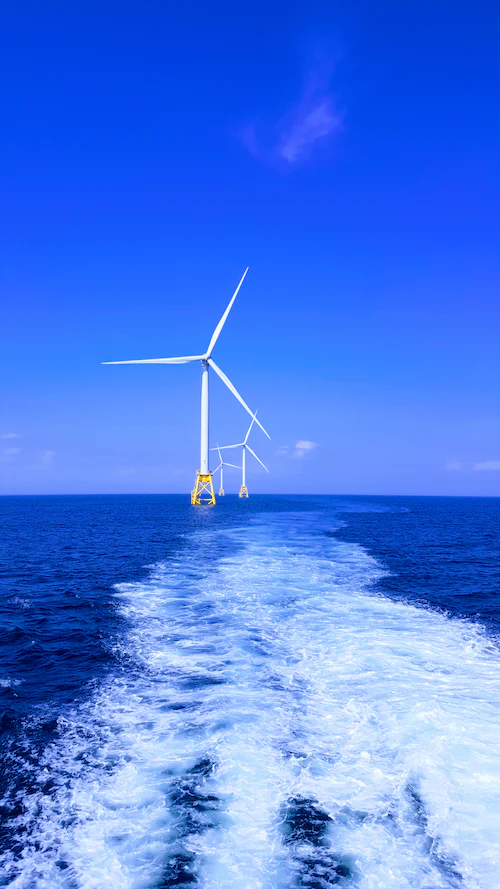Controversy over the Construction of Offshore Wind Farms
Photo by Shaun Dakin on Unsplash
By 2040, New York City (NYC) has committed to 100 percent clean electricity; by 2050, the city has committed to carbon neutrality. Through the installation of solar panels and the current construction of offshore wind farms, NYC is taking large steps to reduce greenhouse gas emissions. In recent months, offshore wind farms in New York and New Jersey have generated some controversy. Despite the massive impact offshore wind farms have in the fight to stop climate change, many environmentalists are concerned about the impact this will make on local marine life. “There is a benefit to offshore wind farms, but the risk to marine life is too large. I think there has to be a better way to fight climate change,” said Grace Loiselle, a junior and environmental activist. Olivia Lanteri, a junior and also an environmental activist, agrees with Loiselle, but Lanteri also feels the offshore wind farms are vital in the fight for climate change. “They’re a great idea in concept, and I’m glad that more bills in Congress are getting passed to fund these projects. However, they do have their downsides: most are costly to make and repair, [they] disrupt marine life, and [they] are, ironically, built using fossil fuels,” said Lanteri.
There is a benefit to offshore wind farms, but the risk to marine life is too large. I think there has to be a better way to fight climate change.
— Grace Loiselle, LHS Class of '24
Offshore wind is a relatively new way to generate clean, renewable energy without emitting any carbon dioxide. Although wind turbines cannot be built without the use of fossil fuels, once in use, they provide large amounts of clean energy, decreasing the demand for fossil fuels, which is the leading cause in global warming. As the 116-foot (on average) blade spins, kinetic energy is created, then a generator converts the kinetic energy into usable electric energy. With more space out at sea, the turbines can be built taller, producing more clean energy. The largest blade on a wind turbine reached 351 feet, about the length of a football field and is located in China. In addition, with stronger winds out at sea, offshore wind farms are more effective than those onshore. Plus, 50 percent of the U.S. population lives near the coast; therefore, offshore wind can produce the energy needed for their homes and businesses. Offshore wind turbines are miles from shore and can be installed up to 3,300 feet deep, affecting homes only by disrupting the view. In a March 28, 2022, NPR article entitled “Misinformation Is Derailing Renewable Energy Projects Across the Unites States,” Leah Stokes, an associate professor of political science at the University of California, Santa Barbara, said, “It can really slow down the clean energy transition, and that has just as dire life and death consequences, not just in terms of climate change, but also in terms of air pollution, which overwhelmingly hits communities of color.”
Offshore wind farms are certainly part of the solution, and I do think we should build more of them, but also while being more mindful of the negatives.
— Olivia Lanteri, LHS Class of '24
This may seem like the perfect solution to fight climate change, but many believe it will cause more harm than good. “Marine life health is an integral part of a functioning society and is definitely worth protecting in all aspects,” said Loiselle. A cause for concern arose recently with over 10 whales washing up on the East Coast through a span of several months, more than recorded in past years. With the recent emergence of the construction of offshore wind farms, many speculated that was the cause. While the deaths have not been connected to the rapid development of wind farms but instead to human interaction and infectious disease amongst the species, this brought nationwide attention to the rise in the development of wind farms. In addition, it brought many doubts to those results as more and more whales are washing up dead along the coasts of Long Island, New York City, and New Jersey. Many wondered whether offshore wind farms cause harm to other marine life. The construction and operation of these offshore wind farms could impact local fishermen as the disturbances can change the abundance and distribution of local fish. Noise pollution is also a main concern as wind turbines cause underwater acoustic vibrations. These sounds can interfere with the behavior of marine mammals since they communicate and navigate the ocean through sounds and vibrations. In addition, the turbine foundations can harmfully influence the sea floor ecosystem by potentially causing hearing damage in species and forcing native species out.
“Offshore wind farms are certainly part of the solution, and I do think we should build more of them, but also while being more mindful of the negatives. While these farms do supply a great amount of energy while active, they shouldn’t be the one green energy source we use; solar, geothermal, hydrothermal, and nuclear are other great sources we should utilize,” said Lanteri. New York continues to develop its five offshore wind projects despite some negative feedback. These offshore wind farms will total more than 4,300 megawatts, powering more than 2.4 million New York homes and providing more than 6,800 jobs. These projects are set to be finished by 2024 at a cost of two billion dollars.

Hello! My name is Amelia Doyle. I am a member of the class of 2024. I play on the varsity volleyball team and the girls' varsity flag football team. I...












































